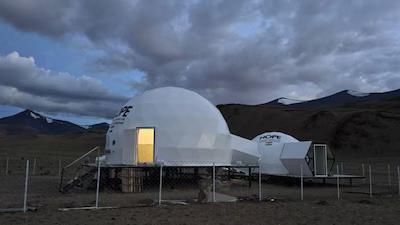
ISRO Sets Up Station in Ladakh to Simulate Life on Moon & Mars
The Indian Space Research Organisation (ISRO) has taken a significant step in its mission to explore the vastness of space by setting up a unique station in Ladakh’s Tso Kar Valley. The Himalayan Outpost for Planetary Exploration (HOPE) is a state-of-the-art facility that will simulate life on the Moon and Mars, helping ISRO to prepare for its future lunar and Martian missions.
Located in the high-altitude Tso Kar Valley, the HOPE station is designed to test life-support systems for lunar and Martian missions. The valley was chosen for its extreme conditions, which are similar to those found on Mars. The region experiences high UV radiation, low atmospheric pressure, and extreme cold temperatures, making it an ideal location for testing the endurance of the systems.
The HOPE station will be operational for a period of 10 days, from August 1 to 10, during which two crew members will conduct various tests and experiments. The crew will be tasked with evaluating the performance of life-support systems, such as air, water, and food, under the harsh conditions of the high-altitude region.
The idea behind setting up the HOPE station is to create a “mini-Mars” environment on Earth, where scientists can test the feasibility of sustaining human life on the red planet. The station will also help ISRO to identify and address any technical challenges that may arise during future missions to the Moon and Mars.
Speaking about the importance of the HOPE station, Dr. K Sivan, Chairman of ISRO, said, “The HOPE station is a critical step towards our ambitious plans to explore the Moon and Mars. By simulating the conditions of these planets on Earth, we can ensure that our life-support systems are robust and reliable, which is essential for the success of our future missions.”
The HOPE station is equipped with advanced technology and equipment, including life-support systems, communication networks, and scientific instruments. The crew members will also have access to a range of scientific experiments and tests, which will help scientists to better understand the behavior of materials and systems under extreme conditions.
The Tso Kar Valley, where the HOPE station is located, is a remote and inhospitable region, with temperatures often dropping to -20°C in the winter months. The region is also characterized by high UV radiation, low atmospheric pressure, and saline permafrost, which are all similar to the conditions found on Mars.
The HOPE station is a significant achievement for ISRO, which has been working towards its mission to explore the Moon and Mars for several years. The organization has already made significant progress in its lunar exploration program, with the successful launch of the Chandrayaan-1 mission in 2008. The mission, which was designed to study the Moon’s surface and subsurface, provided valuable insights into the Moon’s composition and geology.
ISRO is now planning to launch its next lunar mission, Chandrayaan-3, which will include a landing module that will touch down on the Moon’s surface. The mission is expected to provide even more detailed information about the Moon’s composition and geology, and will help scientists to better understand the Moon’s history and evolution.
The HOPE station is also an important step towards ISRO’s ambitious plans to explore Mars. The organization is planning to launch its first Martian mission, Mangalyaan-2, in the next few years, which will include a rover that will explore the Martian surface. The mission will help scientists to better understand the Martian environment, including its geology, climate, and potential for life.
In conclusion, the HOPE station is a significant achievement for ISRO and a major step towards the organization’s mission to explore the Moon and Mars. The station will help scientists to test life-support systems under extreme conditions, and will provide valuable insights into the feasibility of sustaining human life on the red planet. As ISRO continues to push the boundaries of space exploration, the HOPE station is an important milestone in its journey to the stars.






